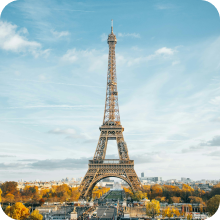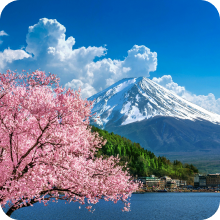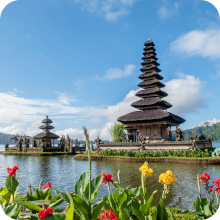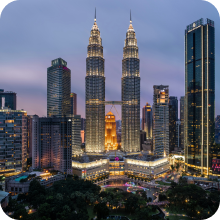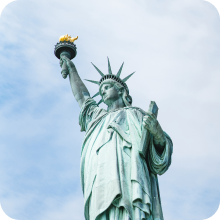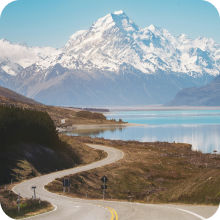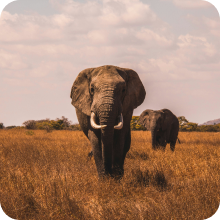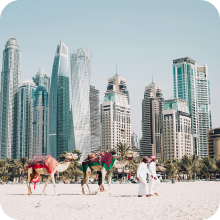Ultimate New Zealand Travel Guide
Planning a trip to New Zealand?
With its snowy mountains, primordial forests, volcanoes, alpine lakes, fjords and beaches, it’s safe to say that New Zealand is a pretty sweet place to explore. It’s stunningly beautiful and offers a stack of adventure sports and activities. Plus, with the local hobbits pottering around and around 27 million sheep, you’ll be in good company.
Before you fly, we’ve put together a little New Zealand travel guide to help make your trip go more smoothly.
TRAVEL COSTS
The currency in New Zealand is the dollar (NZD) and major credit cards are accepted in most places. Prices do vary depending on the place and whether it’s peak season (Dec - Feb), low season (Jun - Aug) or the rest of the year.
Accommodation
- Budget hotels start at around $70 NZD ($66 AUD) per night for a double room.
- Airbnb is really common and a great way to go! You can find rooms in shared houses from around $25 NZD ($24 AUD) per night, or private homes from $70 NZD ($66 AUD) per night.
- New Zealand is a very camping-friendly place, and there are heaps of campgrounds around the country, with paid ones starting from $10 NZD ($9.50 AUD) per night.
- We actually recommend looking into getting a house on wheels - scroll down to the self-drive section.
Food
Eating out in New Zealand isn’t particularly cheap, and can get more expensive in remote areas. Here are a few guidelines of what to expect:
- An average restaurant meal and drink can cost around $35 - $40 NZD ($33 - $38 AUD).
- Cheaper restaurant options are Japanese, Korean and Chinese, which are closer to $10 - $15 NZD ($9.50 - $14 AUD). These are often BYO - yay!
- Fast food chain options come to about $7 - $15 NZD ($6.50 - $14 AUD).
- Hotel breakfasts are roughly $15 - $40 NZD ($14 - $38 AUD).
- Cafe lunches come to $10 - $25 NZD ($9.50 - $24 AUD).
- A beer at a bar is around $8 NZD ($7.60 AUD) - wine is often cheaper! Look out for happy hours at backpacker bars for $5 NZD ($4.70 AUD) beers.
If you’re traveling on a budget, cooking your own food is the way to go. Smaller independent corner stores are usually on the pricey side, so look for any major supermarket such as New World, Countdown and (probably the cheapest) Pak’NSave. Opt for the local Foursquare in smaller towns.
New Zealand travel tips: try the honey lemon ginger tea in cafes. Such a vibe.
Activities
With such a variety of nature and sports on offer, activities are an essential component of any New Zealand holiday guide. Choosing what to do really depends on what you’re going for, but in any case we definitely recommend budgeting extra if you’re into outdoor activities.
It’s worth looking into specific destinations in advance and seeing what’s on offer, but expect to spend anywhere from $30 - $600 NZD ($28 - $568 AUD) for an activity.
New Zealand travel tips: keep an eye on bookme.nz if you’re flexible with dates. You can get some awesome last-minute deals on activities, even up to 50-60% off!
WHEN TO GO
The climate in New Zealand is mild, with subtropical temperatures in the North to quite temperate weather in the South. Each season has something unique to offer and totally transforms the landscapes.
- Summer (Dec - Feb): this is high season for tourism in New Zealand and also coincides with the Kiwi summer holidays, so expect it to be at its busiest. Average daytime temperature is 20 - 25 ̊C, with sunny days and mild nights. It’s the best time of year to go swimming and do water sports.
- Autumn (Mar - May): perhaps the best time to visit New Zealand, autumn sees average daytime temperatures of 17 - 21 ̊C and generally quite pleasant weather to hike or kayak on the lakes. The best golden fall colours peak around the second week of April, especially around Central Otago and Hawke’s Bay, and it’s generally a quiet time for tourism.
- Winter (Jun - Aug): this is low tourist season for New Zealand, but not when it comes to the snow. It can drop to as low as -10 ̊C at night on the South Island, but the average daytime temperature is 12 - 16 ̊C. The North Island especially gets a lot of rain during winter, but it’s a great time to visit glaciers and mountains in the South Island.
- Spring (Sep - Nov): lush with wildflowers and pristine waterfalls, springtime is a colourful time to visit. Average daytime temperature is 16 - 19 ̊C, but it ranges from cold and frosty to sunny and hot. It’s also the best time to go to see hundreds of adorable newborn lambs in the fields.
GETTING AROUND
New Zealand is made up of two main islands, and is well connected by air and road.
Buses
If you don’t want to self-drive during your trip, buses are a great option. Most towns and cities are linked by bus, and the trips are pretty affordable. InterCity is the largest bus network in New Zealand - they do day tour options and also offer a TravelPass option to add on various itineraries.
Prices are much lower if you book a few months in advance. You can expect to pay $55 - $75 NZD ($52 - $71 AUD) to get from Queenstown to Christchurch.
Trains
New Zealand’s train lines are definitely more of a scenic tourist experience than a local convenience. There are three lines available:
- The Northern Explorer (Auckland-Wellington); through Tongariro National Park and the Raurimu Spiral. $199 NZD ($188 AUD) one way.
- The Coastal Pacific (Christchurch-Picton); runs along the coastline of the South Island. $159 NZD ($151 AUD) one way.
- The TranzAlpine (Christchurch-Greymouth); passes through the Southern Alps. $199 NZD ($188 AUD) one way.
It’s a beautiful experience for those wanting to sit back and take in the rolling landscapes, but it’s not a budget option!
Flying
Flying is an easy way to get across the country if you’re pressed for time. Otherwise, it’s not that cheap and you’ll also be missing out on seeing the landscapes along the way, which is a shame!
The main airports are Auckland, Welington, Christchurch and Queenstown, and most parts of the country are accessible by air. Air New Zealand is the main airline, but Jetstar do offer some of the most popular routes and there are smaller local carriers, too.
New Zealand travel tips: if you’re planning on flying to more remote areas via Stewart Island Flights or Air Chathams, make sure you don’t get stung by excess baggage fees! They’re small planes with very strict baggage weight restrictions.
SELF-DRIVE
Arguably the best way to see New Zealand is to self-drive. It gives you the greatest amount of flexibility, you’re constantly surrounded by changing landscapes, and you can get off the beaten tourist paths into some real adventuring!
Cars
You can legally drive in New Zealand (for up to 12 months) on your Australian drivers license. You’ll need to be 21+ years old to rent a car, and keep in mind there’s often an extra fee if you’re under 25. Kiwis drive on the left - same as in Oz - so no worries there, and generally the roads are pretty well built.
Cost depends on a number of factors, including what season you’re going in, how big a car you’re after, what type of insurance you need and any extras you might want. The most basic, smallest cars in low season can start from as low as $9 NZD ($8.50 AUD) per day, and range to $150 NZD ($142 AUD) per day for 8-seaters during high season.
The best way to compare options is to check out websites like:
Campervans
If you want to self-drive and not have to worry about finding accommodation, New Zealand is the perfect place to rent a campervan or motorhome. Especially on the South Island, where the scope of landscapes and nature make hiking and camping very popular, having a home on wheels ensures total flexibility on your trip, even moving around depending on the weather.
The country as a whole is well set up with hundreds of holiday parks, campgrounds and freedom camping sites where you can also pull over for showers, doing laundry and cooking. A simple campsite will cost you between $0 - $26 NZD ($25 AUD), and the more expensive holiday parks can be around $50 NZD ($47 AUD).
The cost of renting a campervan vary a lot, depending on how early you book, what season you’re traveling in, the size of the campervan, and whether or not you’re making a return trip.
During low season (Jun - Aug), campervans can cost $30 - $120 NZD ($28 - $114 AUD) per day. This jumps to $120 - $420 NZD ($114 - $398 AUD) per day during high season (Dec - Feb).
Also consider costs like insurance and your accident or damage liability, and check what inclusions the rental has or if you need to pay extra for things like chairs, linen, towels, snow chains, etc.
The minimum age to rent a campervan is the same as for cars - 21 or older. Definitely make sure you book your campervan in advance, as well as your ferry between Wellington and Picton if you’re planning on driving through both islands.
Check out these websites to compare local campervan options:
New Zealand travel tips: download the apps Rankers or CamperMate to your phone. They’re really handy to have and will point out different types of camping sites, the cost, available facilities and show reviews from other campers.
TRAVEL CONNECTED
We know how convenient being able to access your smartphone is when you’re on holidays. With so many awesome travel apps now accessible, ditch your heavy New Zealand guide book and instead use your phone to navigate, book places to stay and look up things to do. It’s also just nice to be able to stay in touch with family and friends.
Internet in New Zealand isn’t the best though, and free Wi-Fi (that works) can be hard to find. Most campgrounds, hotels and cafes that do offer free Internet also have a data limit, which can be a real pain. What we suggest to make life easier is making sure you can stay connected on the go, especially if you’re planning on self-driving.
Your Aussie SIM card should work in most major cities and towns if your carrier offers international roaming, however at $5 - $10 per day, it can get a little pricey.
We recommend looking into local SIM card options as a more budget-friendly option. These are the three main prepaid SIMs available in New Zealand:
- Spark: there’s a few different package options, such as $49 NZD ($46 AUD) for 4GB of data for 28 days. You can also add international call or text plans for an extra $10 NZD ($9.50 AUD).
- Vodafone: you can customise your prepaid plan online with different amounts of data, calls and texts. For instance, you can get 4GB of data, 50 mins call time and unlimited texts for $40 for 28 days.
- 2degrees: offer some great options for data plans, for instance $55 NZD ($53 AUD) for 10GB and unlimited calls and texts for a month.
Or, if you want to save yourself the hassle of having to buy a local SIM when you land, we can help sort you out. Check out our New Zealand SIM options, pick the best fit for you, buy before you fly, then simply pop it in your phone when you arrive.
Use the Internet to make calls and texts for free when you can, and keep track of your data usage to get the most out of your data.
Expect to have better coverage in the North Island than in the South, but any main town or city should have phone service. Just like back home though, if you’re out in remote places, don’t expect to find more than a tentative bar or two of reception.

